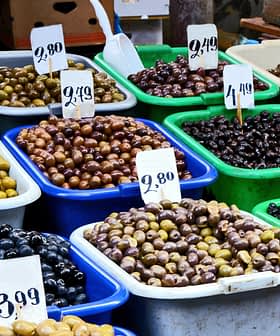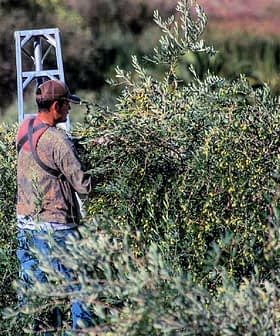Inflation Cuts Premium Food Sales in U.S., but Not Extra Virgin Olive Oil

The price of groceries in the United States has increased by 13.1 percent in the past year, leading to changes in consumer shopping habits. While premium and luxury food purchases have decreased, sales of extra virgin olive oil have remained steady or increased due to its health benefits and unique flavor profile, despite modest price hikes.
The price of groceries in the United States rose by 13.1 percent in the past 12 months, according to the latest data from the Bureau of Labor Statistics, the largest increase of its kind since 1979.
This tangible price increase for all types of food products, ranging from fruit and vegetables (9.3 percent) to dairy (14.9 percent), has altered grocery shopping habits in the U.S.
The olive oil category at retail is gaining unit share from other cooking oils and fats because there hasn’t been as much price inflation.
A report from Attest, a research firm, surveyed “2,000 nationally representative working-age Americans” and found average weekly grocery spending had increased by 14.5 percent compared to six months ago.
To cope with rising prices, Attest found that six in 10 are buying less premium or luxury food. They also saw a 24.9 percent decline in meat-free or flexitarian diets, with one in two consumers switching to cheaper brands.
See Also:Rising Olive Oil Prices Do Not Slow Consumption in EuropeWhile Attest did not collect any data about olive oil consumption trends, its findings echo patterns identified in the United States Department of Agriculture’s most recent oilseeds world market report.
USDA data indicates that olive oil consumption in the U.S. fell from 395,000 tons the in the 2020/21 marketing year (which runs from August to July) to 381,000 tons by the end of 2021/22.
However, not all grades of olive oil fared equally, with importers and U.S. producers reporting no decline in sales of extra virgin olive oil.
“[It’s] tough times for sure,” Joseph R. Profaci, the executive director of the North American Olive Oil Association (NAOOA), a trade group, told Olive Oil Times. “But the situation for olive oil is not so dire.”
“The total U.S. retail pourable oil market (olive oil plus corn, canola, soybean, etc.) is down 4.5 percent in volume, but the olive oil category itself is only down 1.7 percent in volume,” he added, citing 52-week data up to August 13.
Furthermore, there is no evidence that extra virgin olive oil sales have fallen at all. “In fact, in the extra virgin category for package sizes between 10 and 19 ounces, the specialty sector (priced at over $0.75 per ounce) has been steadily growing over the last five years,” Profaci said.
“For the current year to date, volume in the specialty sector is up again relative to the rest of that portion of the extra virgin olive oil category,” he added.
While there has been no specific research as to why other premium food sales have fallen while extra virgin olive oil has steadily increased its upward trend, Profaci believes the health benefits and unique flavor profile of extra virgin olive oil have prevented customers from sacrificing it for alternatives.
“There really is no acceptable substitute for those who are passionate about cooking with olive oil,” he said.
Nick Potter, Costco’s assistant buyer for olive oil and other products, has observed a similar trend at the world’s fifth largest retailer.
“For Costco, we’ve been fortunate. Olive Oil sales have been doing well,” he told Olive Oil Times. “Our sales have increased in the past year.”
Despite some modest price hikes, Potter said Costco members had not seemed to mind. This may be due to similar price increases for other edible oils, such as canola or sunflower.
Along with retailers and importers, producers in the U.S. have also experienced a similar trend of steady or increasing sales, despite inflation.
“We have not experienced a downward trend in our sales,” Jeffrey Campbell, the executive vice president of sales at California Olive Ranch, the largest U.S. olive oil producer, told Olive Oil Times. “In fact, we are seeing an acceleration in our units and dollars over the last quarter.”
While Campbell confirmed that COR had raised its prices in the past 12 months to “accommodate for inflation,” he added that this had not impacted sales.
Conversely, he agreed with Potter that inflation in the canola and sunflower oil sectors made olive oil a more appealing option for some consumers.
“The olive oil category at retail is gaining unit share from other cooking oils and fats because there hasn’t been as much price inflation,” he said.
Campbell also believes that increasing consumer awareness of olive oil’s health benefits has made shoppers less likely to substitute it for other cooking oils.
California Olive Ranch was not alone in observing this trend among U.S. producers. Marisa Bloch, the general manager of Pasolivo, in central California, said the company had increased prices a little bit due to inflation but has not seen a decrease in sales.
“We are fortunate to have a very loyal customer base,” Bloch told Olive Oil Times. She added that educating consumers about the health benefits of extra virgin olive oil is key to increasing consumption in the U.S.
“Many of our customers have seen the effects of the health benefits from our oils, such as lowering their cholesterol, so they continue to purchase as this is one food they definitely don’t want to give up,” Bloch said.
While California is responsible for virtually all U.S. olive oil production, farmers and millers in other states confirmed the same trend: consumers may be cutting back on other luxury food items, but extra virgin olive oil seems to be the exception.
Pioneering Oregonian olive oil producer Paul Durant said that his company had to raise prices slightly last year to offset input cost pressure from inflation, but his customers continue buying olive oil.
“We are fortunate in that more than 65 percent of our sales are direct-to-consumer,” he told Olive Oil Times. “We also self-distribute our oils, so we are very close to our retail partners. We have made a major push for demos to their customer base, which has definitely translated into strong sales on their behalf and ours.”
Instead, Durant said the results of the 2022 olive harvest will have more of an impact on pricing than inflation.
“The real key for us this year will be the yield,” he concluded. “Last year was rough. If I can get my unit costs down on the yield side, it will give me a lot of relief from other pricing pressures.”









